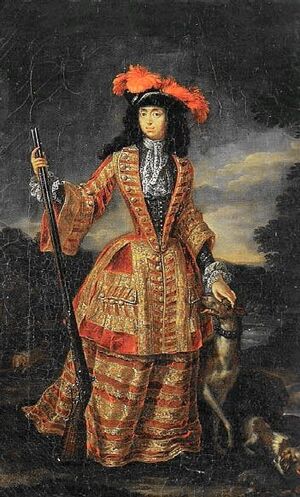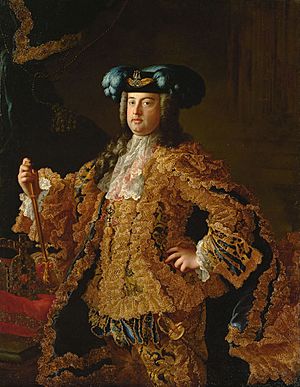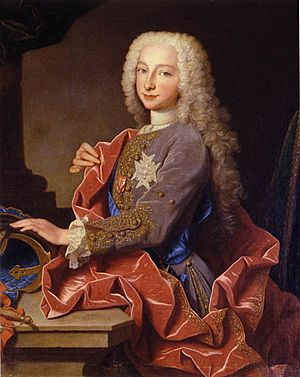Gian Gastone de' Medici, Grand Duke of Tuscany facts for kids
Quick facts for kids Gian Gastone |
|||||
|---|---|---|---|---|---|

Portrait by Franz Ferdinand Richter
|
|||||
| Grand Duke of Tuscany | |||||
| Reign | 31 October 1723 – 9 July 1737 | ||||
| Predecessor | Cosimo III | ||||
| Successor | Francis II Stephen | ||||
| Born | 24 May 1671 Palazzo Pitti, Florence, Tuscany |
||||
| Died | 9 July 1737 (aged 66) Pitti Palace, Florence, Tuscany |
||||
| Burial | Basilica of San Lorenzo | ||||
| Spouse | Anna Maria Franziska of Saxe-Lauenburg | ||||
|
|||||
| House | Medici | ||||
| Father | Cosimo III de' Medici | ||||
| Mother | Marguerite Louise d'Orléans | ||||
| Religion | Roman Catholicism | ||||
Gian Gastone de' Medici (born Giovanni Battista Gastone; 24 May 1671 – 9 July 1737) was the seventh and last Medici Grand Duke of Tuscany. He was the ruler of Tuscany, a region in Italy.
Gian Gastone was the second son of Grand Duke Cosimo III and Marguerite Louise d'Orléans. His sister, Electress Palatine Anna Maria Luisa, helped arrange his marriage to Anna Maria Franziska of Saxe-Lauenburg in 1697. They did not have any children.
Gian Gastone became Grand Duke in 1723 after his father died. His older brother, Grand Prince Ferdinando, had passed away earlier. Gian Gastone's rule brought many changes. He removed some taxes for poorer people and stopped public executions.
The Medici family was running out of male heirs. His father, Cosimo III, wanted Gian Gastone's sister to rule after him. However, other powerful countries like Spain and Austria had different plans. They decided that Charles of Spain would be the next ruler. Later, Charles gave up his claim to Francis Stephen of Lorraine. Francis Stephen became the new Grand Duke when Gian Gastone died on 9 July 1737. This ended nearly 300 years of Medici family rule in Florence.
Contents
Biography
Early Life (1671–1697)
Gian Gastone was born in Florence on 24 May 1671. His parents were Grand Duke Cosimo III and Marguerite Louise d'Orléans. He was named after his mother's father, Gaston, Duke of Orléans. His parents often disagreed, and his mother returned to France when he was young. Gian Gastone and his siblings were raised by their grandmother, Vittoria della Rovere.
Gian Gastone was a very smart and curious person. He loved old artifacts, plants, and science. He could also speak English and other languages. However, his father and older brother, Grand Prince Ferdinando, did not always understand his interests.
His father, Cosimo III, thought about making Gian Gastone a cardinal in the church. But other countries, like Spain, wanted him to have a different role. They offered to make him "General of the Spanish Seas." The King of Portugal also wanted Gian Gastone to marry his daughter. None of these plans worked out.
Gian Gastone became friends with his sister-in-law, Duchess Violante Beatrice of Bavaria. She was married to his brother Ferdinando, who did not treat her well. Gian Gastone felt sad and often spent time alone. His uncle, Cardinal Francesco Maria, tried to cheer him up with parties, but it did not help much.
Marriage and Life in Bohemia (1697–1708)
By 1697, Gian Gastone's brother and sister had no children, which worried the family about the future of their dynasty. Cosimo III asked Gian Gastone's sister, the Electress Palatine, to find him a wife. She suggested Anna Maria Franziska of Saxe-Lauenburg. She was a wealthy widow.
They were married in Düsseldorf on 2 July 1697. Anna Maria Franziska preferred country life over cities and royal courts. She wanted them to live in her homes in Bohemia, Ploskovice Castle and Reichstadt (Zákupy).
Gian Gastone found life in Bohemia difficult. Anna Maria Franziska was sometimes unpredictable and had angry outbursts. After a year, Gian Gastone left her and went to Paris. His father, Cosimo, was angry and told him to go back to Bohemia. Anna Maria Franziska tried to welcome him, but their relationship remained difficult.
Gian Gastone often gambled and got into a lot of debt. His sister told their father about his behavior. Gian Gastone blamed his wife's "moods and sharp words" for his actions. Cosimo sent someone to check on his son's debts. It was clear that Anna Maria Franziska did not want to move to Florence, where Gian Gastone wished to be. He was forced to return to Bohemia.
The Grand Duke Cosimo III eventually got tired of Anna Maria Franziska's stubbornness. He asked the Pope for help, who sent the Archbishop of Prague to tell her she must go to Florence. She refused. So, Cosimo III called Gian Gastone back to Florence in 1708. He never saw his wife again.
Return to Florence (1708–1723)
Gian Gastone did not like his father's very religious nature, so he stayed away from the royal court. Meanwhile, Grand Prince Ferdinando was very ill. This meant Gian Gastone was likely to become the next ruler. Gian Gastone also struggled with his own mental health, often needing to be alone.
When Grand Prince Ferdinando died on 30 October 1713, it caused a problem for who would rule next. Cosimo III tried to make his daughter, the Electress Palatine, Gian Gastone's heir. This plan was sent to other European countries. Austria did not agree, fearing that France would gain too much power in Italy. However, France and England did agree.
The Electress returned to Florence in October 1717 after her husband died. Violante Beatrice, Gian Gastone's friend, did not get along with the Electress. So, Violante Beatrice left the court to become the governor of Siena. Gian Gastone and his sister were not on good terms either. He blamed her for his unhappy marriage.
On 4 April 1718, major European powers decided that Charles of Spain would be the heir to Tuscany. Charles was related to the Medici family through his mother. The Electress's right to the throne was ignored. Cosimo III made one last statement before he died on 31 October 1723, saying that the Electress should succeed Gian Gastone. But his wishes were not followed.
Reign (1723–1737)

When Gian Gastone became Grand Duke, Tuscany was in a difficult state. The army was small, the treasury was empty, and many people in Florence were poor. Despite these problems, Gian Gastone, at 52 years old, began his rule with enthusiasm. He released prisoners, removed high taxes, and stopped public executions.
Gian Gastone brought Governor Violante Beatrice back to the royal court. He sent his sister, the Dowager Electress, to live in a villa outside the city. Violante Beatrice helped Gian Gastone with many of his public duties.
From 1723 to 1731, European powers worked to decide who would rule Tuscany next. Spain wanted Charles of Spain, but Austria did not want another French-related ruler in Italy. Gian Gastone knew his sister probably would not become ruler. So, he made sure she would inherit all the Medici family's private property, separate from the state's possessions.
Violante Beatrice and the Dowager Electress, despite their disagreements, tried to improve Gian Gastone's public image. Violante Beatrice organized parties to encourage him to be more social. However, his behavior at these events was sometimes shocking, and guests would leave quickly. These parties stopped when Violante Beatrice died in 1731. Gian Gastone was very sad to lose her.
Rumors spread that the Grand Duke had died because people rarely saw him. To stop these rumors, the Dowager Electress convinced Gian Gastone to make a public appearance in 1729. This was his last public appearance. After spraining his ankle in July 1729, the Grand Duke stayed in bed for most of the rest of his life.
The future of Tuscany was finally decided by the Treaty of Vienna (1731). Infante Charles was confirmed as Gian Gastone's heir. Gian Gastone was not consulted about this decision. Thirty thousand Spanish troops arrived in Tuscany in October 1731. Charles arrived in Florence the next March. Gian Gastone liked Charles very much and gave him many gifts.
After a war broke out in 1733, Charles moved his army south and defeated the Austrians in Naples and Sicily. In 1735, it was agreed that Charles would give up his claim to Tuscany to Francis III of Lorraine. In return, Charles would become king of Naples and Sicily. Neither Gian Gastone nor Francis III were asked about this. Gian Gastone was upset because he had grown fond of Charles and did not want a foreigner to rule Tuscany. Spanish troops left Tuscany in January 1737, and Austrian troops arrived for Francis.
Death and Legacy

By the time the Spanish troops left, the Grand Duke was very ill. One of his last wishes was to have a statue of Galileo Galilei built in the Basilica of Santa Croce. His sister, Anna Maria Luisa, came to his bedside when it was clear he would not recover. Gian Gastone could not eat, and his health worsened. Anna Maria Luisa made sure he was comfortable.
On 9 July 1737, Gian Gastone, the last Medici Grand Duke, passed away. His sister, Anna Maria Luisa, inherited all the private family possessions. However, as planned by the powerful European countries, Francis of Lorraine became the new Grand Duke of Tuscany.
Gian Gastone worked hard to improve his realm. He removed corrupt church officials from the government and allowed the teaching of "new ideas," like Galileo's philosophy, at the University of Pisa. He also got rid of heavy income taxes. Because of these changes, his people truly mourned him. Many Tuscans wished the Medici family could return to power.
Gian Gastone was buried in the Medici family tomb, the Basilica of San Lorenzo. His body was dressed in black velvet and royal robes. His crown and scepter were placed with him.
Today, you cannot easily see his tomb slab. His remains are actually under a different stone nearby, in an underground burial chamber. Many other Medici family members are buried there, including children in unmarked graves.
Gian Gastone was not the very last person descended from the Medici family. Other branches of the family continued, and some European kings, like those of France, were also related to the Medici through earlier family connections.
Titles and Styles
- 30 October 1713 – 31 October 1723: His Royal Highness The Grand Prince of Tuscany
- 31 October 1723 – 9 July 1737: His Royal Highness The Most Serene Grand Duke of Tuscany
Images for kids
-
Anna Maria Luisa de' Medici, Electress Palatine of the Rhine, Gian Gastone's sister, painted by Jan Frans van Douven
-
Charles of Spain by Jean Ranc, 1725
-
Francis III of Lorraine, Gian Gastone's successor, painted by Martin van Meytens, 1745
See also
 In Spanish: Juan Gastón de Médici para niños
In Spanish: Juan Gastón de Médici para niños








